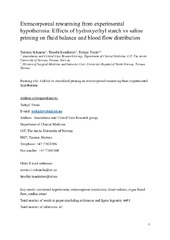| dc.contributor.author | Schanche, Torstein Lindahl | |
| dc.contributor.author | Kondratyev, Timofey | |
| dc.contributor.author | Tveita, Torkjel | |
| dc.date.accessioned | 2020-06-11T07:40:00Z | |
| dc.date.available | 2020-06-11T07:40:00Z | |
| dc.date.issued | 2019-08-29 | |
| dc.description.abstract | Rewarming by extracorporeal circulation (ECC) is the recommended treatment for accidental hypothermia patients with cardiac instability. Hypothermia, along with initiation of ECC, introduces major changes in fluid homeostasis and blood flow. Scientific data to recommend best practice use of ECC for rewarming these patients is lacking, and no current guidelines exist concerning the choice of priming fluid for the extracorporeal circuit. The primary aim of this study was to compare the effects of different fluid protocols on fluid balance and blood flow distribution during rewarming from deep hypothermic cardiac arrest. Sixteen anaesthetized rats were cooled to deep hypothermic cardiac arrest and rewarmed by ECC. During cooling, rats were equally randomized into two groups: an extracorporeal circuit primed with saline or primed with hydroxyethyl starch (HES). Calculations of plasma volume (PV), circulating blood volume (CBV), organ blood flow, total tissue water content, global O2 delivery and consumption were made. During and after rewarming, the pump flow rate, mean arterial pressure, PV and CBV were significantly higher in HES‐treated compared with saline‐treated rats. After rewarming, the HES group had significantly increased global O2 delivery and blood flow to the brain and kidneys compared with the saline group. Rats in the saline group demonstrated a significantly higher total tissue water content in the kidneys, skeletal muscle and lung. Compared with crystalloid priming, the use of an iso‐oncotic colloid prime generates less tissue oedema and increases PV, CBV and organ blood flow during ECC rewarming. The composition of fluid additions appears to be an important factor during ECC rewarming from hypothermia. | en_US |
| dc.description | This is the peer reviewed version of the following article:<i>Extracorporeal rewarming from experimental hypothermia: Effects of hydroxyethyl starch versus saline priming on fluid balance and blood flow distribution</i> which has been published in final form at https://doi.org/10.1113/EP087786. This article may be used for non-commercial purposes in accordance with Wiley Terms and Conditions for Use of Self-Archived Versions. | en_US |
| dc.identifier.citation | Schanche, T.; Kondratyev, T.V.; Tveita, T.(2019) Extracorporeal rewarming from experimental hypothermia: Effects of hydroxyethyl starch versus saline priming on fluid balance and blood flow distribution. <i>Experimental Physiology, 104</i>, (9), 1353-1362 | en_US |
| dc.identifier.cristinID | FRIDAID 1719158 | |
| dc.identifier.doi | 10.1113/EP087786 | |
| dc.identifier.issn | 0958-0670 | |
| dc.identifier.issn | 1469-445X | |
| dc.identifier.uri | https://hdl.handle.net/10037/18512 | |
| dc.language.iso | eng | en_US |
| dc.publisher | Wiley / The Physiological Society | en_US |
| dc.relation.ispartof | Schanche, T.L. (2025). Resuscitation from severe accidental hypothermia - An experimental study with special reference to management of hypothermia-induced cardiovascular dysfunction and cardiac arrest. (Doctoral thesis). <a href=https://hdl.handle.net/10037/37118>https://hdl.handle.net/10037/37118</a> | |
| dc.relation.journal | Experimental Physiology | |
| dc.relation.projectID | info:eu-repo/grantAgreement/RCN/Petromax2 | en_US |
| dc.relation.projectID | info:eu-repo/grantAgreement/Ministry of Foreign Affairs/Barents 2020 | en_US |
| dc.rights.accessRights | openAccess | en_US |
| dc.rights.holder | © 2020 The Physiological Society | en_US |
| dc.subject | VDP::Medical disciplines: 700::Clinical medical disciplines: 750 | en_US |
| dc.subject | VDP::Medisinske Fag: 700::Klinisk medisinske fag: 750 | en_US |
| dc.title | Extracorporeal rewarming from experimental hypothermia: Effects of hydroxyethyl starch versus saline priming on fluid balance and blood flow distribution | en_US |
| dc.type.version | acceptedVersion | en_US |
| dc.type | Journal article | en_US |
| dc.type | Tidsskriftartikkel | en_US |
| dc.type | Peer reviewed | en_US |


 English
English norsk
norsk